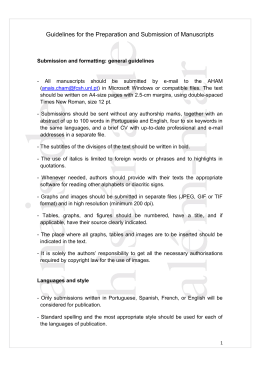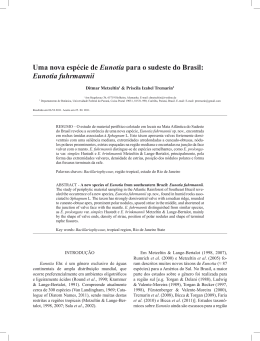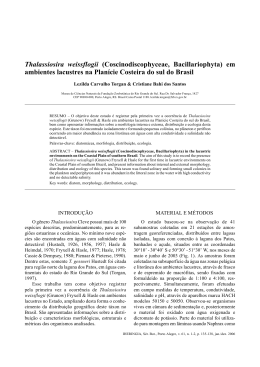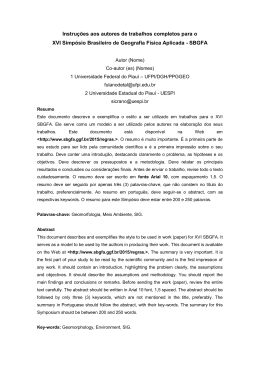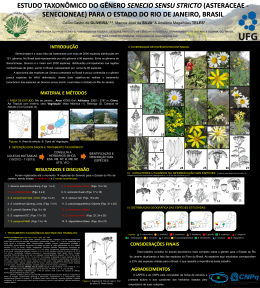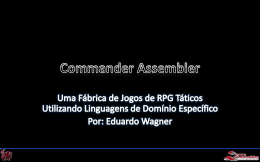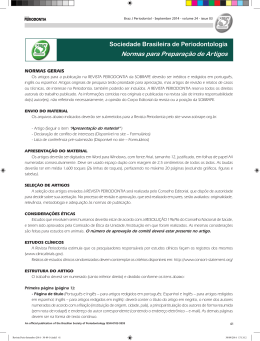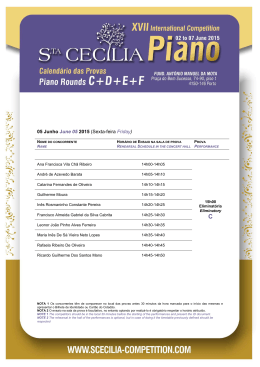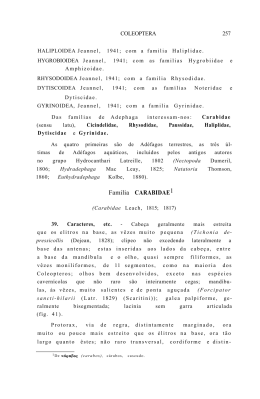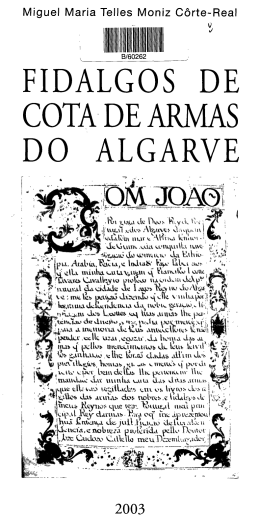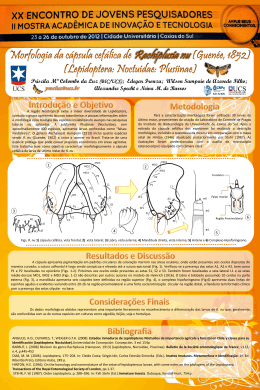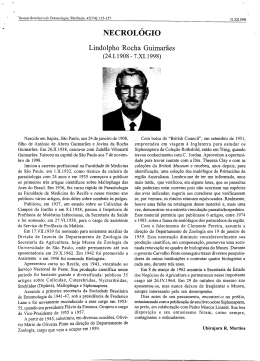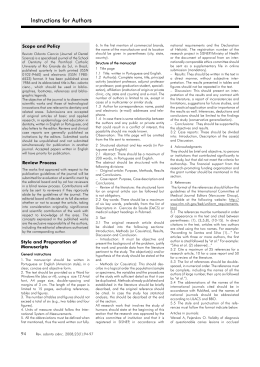Normas para submissão do manuscrito Iheringia, Série Botânica, periódico editado pelo Museu de Ciências Naturais, Fundação Zoobotânica do Rio Grande do Sul, destina-se à publicação semestral de artigos, revisões e notas científicas originais sobre assuntos relacionados a diferentes áreas da Botânica. O manuscrito pode ser redigido em português, espanhol e inglês, recebendo este último idioma prioridade de publicação e será avaliado por no mínimo dois revisores e corpo editorial. Os artigos após publicação ficarão disponíveis em formato digital (pdf) no site da Fundação Zoobotânica do Rio Grande do Sul (http://www.fzb.rs.gov.br/conteudo/2135/?Iheringia_S%C3%A9rie_Bot%C3%A2nica) e no portal da CAPES. A revista encontra-se indexada no Web of Science – Institute for Scientific Information (ISI). O encaminhamento do manuscrito deverá ser feito em uma via impressa e uma cópia em CDRW para a editora-chefe no endereço: Museu de Ciências Naturais, Fundação Zoobotânica do RS, Rua Salvador França, 1427, CEP 90690-000, Porto Alegre, RS. O manuscrito deve ser escrito em fonte Times New Roman, tamanho 12, espaço 1,5, em páginas numeradas (máximo de 40 páginas incluindo figuras). A apresentação dos tópicos Título, Resumo, Abstract, Introdução, Material e Métodos, Resultados e/ou Discussão, Conclusões, Agradecimentos e Referências deve seguir o estilo dos artigos publicados no último número da revista, encontrado no site. A nota (no máximo seis páginas) destina-se a comunicações breves de resultados originais, não sendo necessário apresentar todos os tópicos de um artigo. O nome dos autores é seguido apenas pelo endereço profissional e e-mail. Menção de parte de dissertação de mestrado ou tese de doutorado é indicada por número sobrescrito, abaixo do título do manuscrito. O Resumo, com no máximo 150 palavras, deve conter as mesmas informações que o Abstract. Palavras-chave e key words devem ter no máximo cinco palavras em ordem alfabética, separadas por vírgulas, e não podem ser as mesmas que se encontram no título. O resumo em inglês (abstract) deve ser precedido pelo título do mansucrito, também em inglês. Quando o manuscrito for escrito em inglês ou espanhol deverá conter um resumo em português precedido pelo título em português. Nomes taxonômicos de qualquer categoria são escritos em itálico. Os nomes genéricos e específicos, ao serem citados pela primeira vez no texto, são acompanhados pelo(s) nomes do(s) seu(s) autor(es). Para as abreviaturas de autores, livros e periódicos deve-se seguir “The International Plant Names Index” (http://www.ipni.org/index.html), “The Taxonomic Literature (TL-2)”,“Word List of Scientific Periodicals” ou “Journal Title Abbreviations” (http://library.caltech.edu/reference/abbreviations). Nos manuscritos de abordagem taxonômica, as chaves de identificação devem ser preferencialmente indentadas e os autores dos táxons não devem ser citados. No texto, os táxons são apresentados em ordem alfabética e citados como segue (basônimo e sinônimo não são obrigatórios). Bouteloua megapotamica (Spreng.) Kuntze, Revis. Gen. Pl. 3 (3): 341. 1898. Pappophorum megapotamicum Spreng., Syst. Veg. 4: 34. 1827. Eutriana multiseta Nees, Fl. Bras. 2(1): 413. 1829. Pappophorum eutrianoides Trin. ex Nees, Fl. Bras. Enum. Pl. 2(1): 414. 1829. Bouteloua multiseta Griseb., Abh. Königl. Ges. Wiss. Göttingen 24: 303. 1879. ( Figs. 31-33) O material examinado é apresentado em tabela ou citado na seguinte sequência: país, estado, município, local específico listado em ordem alfabética, seguindo-se a data, nome e número do 2 coletor e sigla do Herbário, ou o número de registro no herbário, na inexistência do número de coletor, conforme os exemplos: Material examinado: ARGENTINA, MISIONES, Depto. Capital, Posadas, 11.I.1907, C. Spegazzini s/nº (BAB 18962). BRASIL, ACRE, Cruzeiro do Sul, 24.V.1978, S. Winkler 698 (HAS); RIO GRANDE DO SUL, Santa Maria, Reserva Biológica do Ibicuí-Mirim, 10.XII.1992, M.L. Abruzzi 2681 (HAS); Uruguaiana, 12.III.1964, J. Mattos & N. Mattos,5345 (HAS, ICN). VENEZUELA, Caracas, 15.III.1989, J. C. Lindeman 3657 (VEN). Material examinado: BRASIL, RIO GRANDE DO SUL, Mato Leitão, arroio Sampaio, estação 1, 10.V.1995, lâmina nº 4899 (HAS 34015); arroio Sampainho, estação 2, 5.VIII.1994, lâmina nº 4903 (HAS 34017). Palavras de origem latina (et al., apud, in, ex, in vivo, in loco, in vitro ...) são escritas em itálico e as palavras estrangeiras entre aspas. As citações de literatura no texto são dispostas em ordem alfabética e cronológica da seguinte forma: Crawford (1979) ou (Crawford 1979); (Bawa 1990, Free 1993); (Smith & Browse 1986) ou Smith & Browse (1986); Round et al. (1992) ou (Round et al. 1992). As Referências Bibliográficas devem conter todos os autores e ser apresentadas sem justificar, obedecendo os espaços simples ou duplos, entre os autores, ano, título do artigo ou livro e do periódico (citado por extenso). As citações de dissertações e teses são incluídas somente em casos estritamente necessários. O seguinte estilo deve ser usado para as Referências Bibliográficas: Capítulo de livro Barbosa, D.C.A., Barbosa, M.C.A. & Lima, L.C.M. 2003. Fenologia de espécies lenhosas da Caatinga. In Ecologia e conservação da Caatinga (I.R. Leal, M. Tabarelli & J.C.M. Silva, eds.). Universidade Federal de Pernambuco, Recife, p. 657-693. Livro Barroso, G.M., Morim, M.P., Peixoto, A.L. & Ichaso, C.L.F. 1999. Frutos e Sementes. Morfologia Aplicada à Sistemática de Dicotiledôneas. Universidade Federal de Viçosa, Viçosa. 443 p. Obra seriada Bentham, G. 1862. Leguminosae. Dalbergiae. In Flora brasiliensis (C.F.P. Martius & A.G. Eichler, eds.). F. Fleischer, Lipsiae, v.15, part. 1, p. 1-349. Artigos em anais de congresso Döbereiner , J. 1998. Função da fixação de nitrogênio em plantas não leguminosas e sua importância no ecossistema brasileiro. In Anais do IV Simpósio de Ecossistemas Brasileiros (S. Watanabe, coord.). Anais da Academia de Ciências de São Paulo, São Paulo, p. 1-6. Smith, A.B. 1996. Diatom investigation. In Proceedings of the Nth International Diatom Symposium (X.Y. Brown, ed.). Biopress, Bristol, p.1-20. Livro de uma serie Förster, K. 1982. Conjugatophyceae: Zygnematales und Desmidiales (excl. Zygnemataceae). In Das Phytoplankton des Süsswassers: Systematik und Biologie (G. Huber-Pestalozzi, ed.). Schweizerbart’sche Verlagsbuchhandlung, Stuttgart, Band 16, Teil 8, Hälfte 1, p. 1-543. Metzeltin, D., Lange-Bertalot, H. & Garcia-Rodriguez, F. 2005. Diatoms of Uruguay. In Iconographia Diatomologica. Annoted diatom micrographs. (H. Lange-Bertalot, ed.). Gantner Verlag, Ruggell, v. 15, 736 p. Referência via eletronica Guiry, M.D. & Dhonncha, E. 2004. AlgaeBase. World eletronic publication. Disponível em: http://www.algaebase.com. Acessado em 18.02.2005. Periódico Nervo, M.H. & Windisch, P.G. 2010. Ocorrência de Pityrogramma trifoliata (L.) R. M. Tryon (Pteridaceae) no estado do Rio Grande do Sul, Brasil. Iheringia. Série Botânica 65(2):291-293. Tese ou dissertação 2 3 Werner, V. 2002. Cyanophyceae/Cyanobacteria no sistema de lagoas e lagunas da Planície Costeira do estado do Rio Grande do Sul, Brasil. Tese 363 f., Universidade Estadual Paulista Júlio de Mesquita Filho, São Paulo. Siglas e abreviaturas, quando mencionadas pelas primeira vez, são precedidas por seu significado por extenso. Na escrita de dados numéricos, os números não inteiros, sempre que possível, deverão ser referidos com apenas uma casa decimal e as unidades de medida abreviadas, com um espaço entre o número e a unidade (Ex. 25 km; 3 cm, 2-2,4 m). Os números de um a dez são escritos por extenso (excetuando-se medidas e quantificação de caracteres) e para os números com mais de três dígitos o ponto deve ser utilizado. As tabelas e figuras são numeradas sequencialmente com algarismos arábicos e suas citações no texto devem ser abreviadas como (Tab. ou Tabs.) e (Fig. ou Figs.) ou escritas por extenso, quando pertinente. Devem vir intercaladas no texto com seus títulos e legendas, respectivamente. As figuras (imagens e desenhos) devem ser de alta resolução e salvas em formato TIF. A disposição das ilustrações deve ser proporcional ao espaço disponível (23 x 8,1 ou 17,2 cm, no caso de uma ou duas colunas, respectivamente), incluindo o espaço a ser ocupado pela legenda. As escalas (barras) deve estar graficamente representada ao lado das ilustrações e seu valor referenciado na legenda. As legendas das figuras são apresentadas em folha à parte. A citação do(s) nome(s) do(s) autor(es) do(s) táxon(s) é opcional. Veja exemplos abaixo: Figs. 1-6. 1, 2. Navicula radiosa: vista interna (MEV); 2. Vista externa (MEV); 3. Pinnularia borealis (MO); 4. P. viridis; 5. Surirella ovalis (MO); 6. S. tenuis (MET). Barras: Figs. 1, 2, 6 = 5 m; Figs. 3-5 = 10 m. Figs. 1-5. Paspalum pumilum Nees. 1. Hábito; 2. Gluma II (vista dorsal); 3. Lema I (vista dorsal); 4. Antécio II (vista dorsal); 5. Antécio II (vista ventral). ( Canto-Dorow 24 – ICN). Figs. 1-3. Padrão de venação dos folíolos. 1. Lonchocarpus muehlbergianus (J. A. Jarenkow 2386 - ICN); 2. L. nitidus (A. Schultz 529 ICN); 3. L. torrensis (N. Silveira et al. 1329 - HAS). Figs. 3 A-C. Eragrostis guianensis. A. Hábito; B. Espigueta; C. Antécio inferior reduzido ao lema e semelhante às glumas (Coradin & Cordeiro 772 - CEN). Barras = 1 mm. Em 12 de junho de 2014 Lezilda Carvalho Torgan Editora-chefe 3 4 Guidelines for manuscripts submission Iheringia, Série Botânica, journal edited by the Museu de Ciências Naturais, Fundação Zoobotânica do Rio Grande do Sul, publishes twice a year research articles, reviews and original scientific notes on issues related to different areas of Botany. The manuscripts should be written in Portuguese, Spanish or English, the later having priority of publication, they will be evaluated by at least two reviewers and editorial staff. After the printed edition is out, the papers will be available in digital format (pdf) on (http://www.fzb.rs.gov.br/conteudo/2135/?Iheringia_S%C3%A9rie_Bot%C3%A2nica) and on the CAPES website. The journal is indexed in Web of Science – ISI. One printed and one CD-RW copy should be sent to Editor-in- chief, at the address: Museu de Ciências Naturais, Fundação Zoobotânica do RS, Rua Salvador França, 1427, CEP 9060-000, Porto Alegre, RS. The manuscript should be formatted in Times New Roman, size 12, double- spaced, with numbered pages (not exceeding forty pages including figures). The manuscript format (Title, Abstract in Portuguese and English, Introduction, Material and Methods, Results and/or Discussion, Conclusions, Acknowledgments and References) must comply with the format of the latest articles published on the Journal found on the website. Scientific notes (not exceeding six pages), should be communications of original results and do not have to necessarily present all topics of an article. The authors names must be followed only by the professional address and e-mail. Reference to the article as part of an academic Thesis or Dissertation is indicated by a superscript number, below the title of the manuscript. The Summary and Abstract, not exceeding 150 words, should contain the same information. No more than five key words in alphabetical order, separated by comma are allowed, and they should not be the same words that appear in the title. The abstract should be preceded by the title of the manuscript. When the manuscript is written in Spanish it should have an abstract in Portuguese preceded by the title in Portuguese as well. Taxonomic names of any category are written in italics. The generic and specific names, when cited for the first time in the text should be followed by their authors. The journals, books and authors abbreviations must be in compliance with The International Plant Names Index (http://www.ipni.org/index.html), The Taxonomic Literature (TL-2), Word List of Scientific Periodicals or Journal Title Abbreviations (http://library.caltech.edu/reference/abbreviations). In taxonomic manuscripts, identification Keys should preferably be indented and the authors of the taxa should not be cited. In the text the taxa are to be presented in alphabetical order and cited as follows (basionym and synonym are not obligatory). Bouteloua megapotamica (Spreng.) Kuntze, Revis. Gen. Pl. 3 (3): 341. 1898. Pappophorum megapotamicum Spreng., Syst. Veg. 4: 34. 1827. Eutriana multiseta Nees, Fl. Bras. 2(1): 413. 1829. Pappophorum eutrianoides Trin. ex Nees, Fl. Bras. Enum. Pl. 2(1): 414. 1829. Bouteloua multiseta Griseb., Abh. Königl. Ges. Wiss. Göttingen 24:303. 1879. ( Figs. 31-33) The material examined may be presented as a table or cited in the following sequence: country, state, city, specific place listed in alphabetical order, then date, collector’s name and number and Herbarium’s acronym or the Herbarium’s registration number when the collectors’ number does not exist, according to the following examples. Examined material: ARGENTINA, MISIONES, Depto. Capital, Posadas, 11.I.1907, C. Spegazzini s/nº (BAB 18962). BRASIL, ACRE, Cruzeiro do Sul, 24.V.1978, S. Winkler 698 (HAS); RIO GRANDE DO 4 5 SUL, Santa Maria, Reserva Biológica do Ibicuí-Mirim, 10.XII.1992, M.L. Abruzzi 2681 (HAS); Uruguaiana, 12.III.1964, J. Mattos & N. Mattos 5345 (HAS, ICN). VENEZUELA, Caracas, 15.III.1989, J. C. Lindeman 3657 (VEN). Examined material: BRASIL, RIO GRANDE DO SUL, Mato Leitão, arroio Sampaio, estação 1, 10.V.1995, lâmina nº 4899 (HAS 34015); arroio Sampainho, estação 2, 5.VIII.1994, lâmina nº 4903 (HAS 34017). Latin words (et al., apud, in, ex, in vivo, in loco, in vitro ...) must be written in italic and foreign words in quotation marks. References in the text should be in alphabetical and chronological order, such as the following: Crawford (1979) or (Crawford 1979); (Bawa 1990, Free 1993); Smith & Browse (1986) or Smith & Browse (1986); Round et al. (1992) or (Round et al. 1992). The references should contain all the authors, and have to be presented without justifying with simple or double spaces between authors, year, title of the article or book, citing the Journals in full. Dissertations and Thesis citations can be included only in exceptional cases. The style to be used for references is as follows: Book chapter Barbosa, D.C.A., Barbosa, M.C.A. & Lima, L.C.M. 2003. Fenologia de espécies lenhosas da Caatinga. In Ecologia e conservação da Caatinga (I.R. Leal, M. Tabarelli & J.C.M. Silva, eds.). Universidade Federal de Pernambuco, Recife, p. 657-693. Book Barroso, G.M., Morim, M.P., Peixoto, A.L. & Ichaso, C.L.F. 1999. Frutos e Sementes. Morfologia Aplicada à Sistemática de Dicotiledôneas. Universidade Federal de Viçosa, Viçosa. 443 p. Serial Issues Bentham, G. 1862. Leguminosae. Dalbergiae. In Flora brasiliensis (C.F.P. Martius & A.G. Eichler, eds.). F. Fleischer, Lipsiae v.15, part. 1, p. 1-349. Congress Records papers Döbereiner , J. 1998. Função da fixação de nitrogênio em plantas não leguminosas e sua importância no ecossistema brasileiro. In Anais do IV Simpósio de Ecossistemas Brasileiros (S. Watanabe, coord.). Anais da Academia de Ciências de São Paulo, São Paulo, p. 1-6. Books of a Series Förster, K. 1982. Conjugatophyceae: Zygnematales und Desmidiales (excl. Zygnemataceae). In Das Phytoplankton des Süsswassers: Systematik und Biologie (G. Huber-Pestalozzi, ed.). Schweizerbart’sche Verlagsbuchhandlung, Stuttgart, Band 16, Teil 8, Hälfte 1, p. 1-543. Metzeltin, D., Lange-Bertalot, H. & Garcia-Rodriguez, F. 2005. Diatoms of Uruguay. In Iconographia Diatomologica. Annoted diatom micrographs. (H. Lange-Bertalot, ed.). Gantner Verlag, Ruggell v. 15, 736 p. Electronic Reference Guiry, M.D. & Dhonncha, E. 2004. AlgaeBase. World eletronic publication. Available in: http://www.algaebase.com. Acessed in 18.02.2005. Journal Nervo, M.H. & Windisch, P.G. 2010. Ocorrência de Pityrogramma trifoliata (L.) R. M. Tryon (Pteridaceae) no estado do Rio Grande do Sul, Brasil. Iheringia. Série Botânica 65(2):291-293. Smith, A.B. 1996. Diatom investigation. In Proceedings of the Nth International Diatom Symposium (X.Y. Brown, ed.). Biopress, Bristol, p.1-20. Thesis or Dissertation Werner, V. 2002. Cyanophyceae/Cyanobacteria no sistema de lagoas e lagunas da Planície Costeira do estado do Rio Grande do Sul, Brasil. Tese 363 f . Universidade Estadual Paulista Júlio de Mesquita Filho, São Paulo. Acronyms and abbreviations when first mentioned should be preceded by their meaning in full. As for numerical data, non-integer numbers should be written to the tenth decimal point whenever possible, and abbreviated units of measurement with a space between the number and the 5 6 unit (eg. 25 km, 3 cm, 2-2.4 mm). Numbers from one to ten must be written in full (exceptions are for character measurements and quantifications) and for numbers with more than three digits the comma must be used. Tables and figures are numbered sequentially with Arabic numerals, and their citations in the text should be abbreviated as (Tab. or Tabs.) and (Fig. or Figs.) or written out, when appropriate. They should come interspersed in the text along with their titles and captions. Figures (images and pictures) must be high resolution and saved in TIF format. Plates should be a maximum 23cm long x 17.2 cm wide for a full page, or column size of 23 cm long x 8.1 cm wide, including captions. The scales (bars) should be depicted beside the illustrations and their values should be referenced in the caption. The figures captions should be presented on a separate sheet. The citation of the taxa author(s) name(s) is optional. See the examples below: Figs 1-6. 1, 2. Navicula radiosa: internal view (MEV); 2. External view (MEV); 3. Pinnularia borealis (MO); 4. P. viridis; 5. Surirella ovalis (MO); 6. S. tenuis (MET). Bars: Figs 1, 2, 6 = 5 m; Figs 3-5 = 10 m. Figs 1-5. Paspalum pumilum Nees. 1. Habit; 2. Upper glume (vista dorsal); 3. First lemma (dorsal view); 4. Second anthecium (dorsal view); 5. Second anthecium (ventral view). (Canto-Dorow 24 – ICN). Figs 1-3. Venation pattern of the leaflets. 1. Lonchocarpus muehlbergianus (J. A. Jarenkow 2386 - ICN); 2. L. nitidus (A. Schultz 529 ICN); 3. L. torrensis (N. Silveira et al. 1329 - HAS). Figs 3A-C. Eragrostis guianensis. A. Habit; B. Spikelet; C. Lower anthecium reduced to the lemma and similar to the glumes (Coradin & Cordeiro 772 - CEN). Bars = 1 mm. June 12, 2014 Lezilda Carvalho Torgan Editor-in-chief 6
Download
